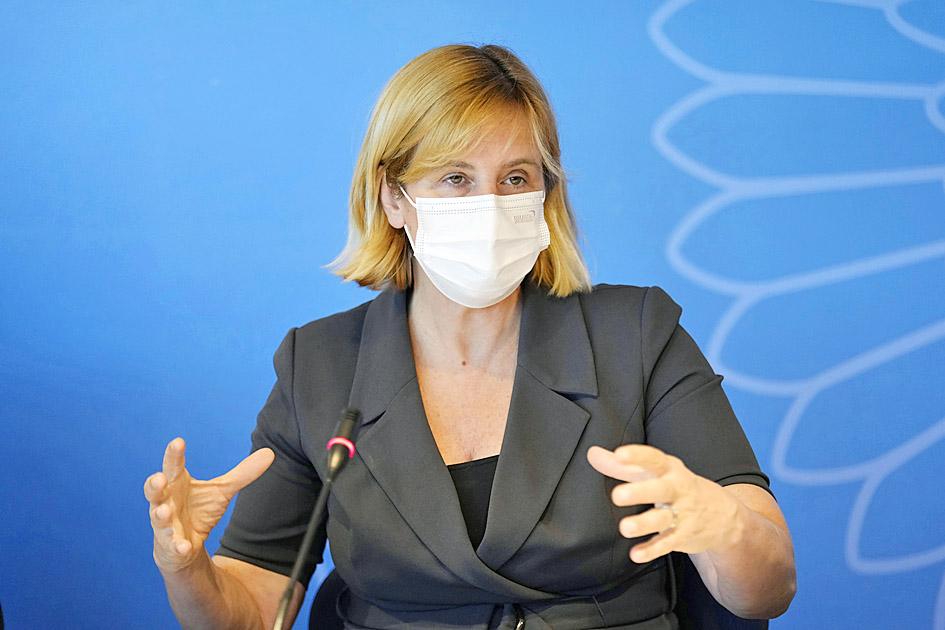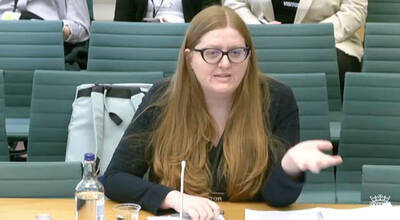New Taiwan-US trade negotiations could move more quickly than broader talks with 12 Indo-Pacific nations, given strong interest in Taipei and Washington to deepen economic ties, Deputy US Trade Representative Sarah Bianchi said on Thursday.
There are parallels between the newly launched Indo-Pacific Economic Framework (IPEF) and the “Taiwan-US Initiative on 21st-century Trade,” Bianchi told Reuters in an interview, but the latter initiative is aimed at increasing links with Taiwan on specific economic issues.
“I think we are eager to get going with Taiwan and to scope out our negotiating mandate there and ... a range of issues from small-medium enterprises to digital trade to labor, and we look forward to getting going as quickly as possible,” Bianchi said.

Photo: AP
Asked if the initiative could bear fruit sooner than the IPEF talks, she said: “Potentially yes, it could.”
China on Thursday said it “firmly opposes” the talks, with Chinese Ministry of Commerce spokesman Gao Feng (高峰) telling Washington to “prudently handle trade and economic ties with Taiwan to avoid sending a wrong message to Taiwan separatists.”
Asked about the Chinese response, US Department of State spokesman Ned Price told reporters: “I can’t speak to the PRC’s [People’s Republic of China’s] reaction.”
“What I can say is that everything we do in the context of our unofficial relationship with Taiwan is done pursuant to our longstanding ‘one China’ policy, which of course is guided by the Taiwan Relations Act, the three US-China joint communiques and the ‘six assurances’ as well,” Price said in Washington.
As for the talks themselves, he said the US intends to “move quickly to develop a road map for possible negotiations,” followed by in-person meetings in Washington.
Taiwan was excluded from the 14-nation IPEF, launched last week by US President Joe Biden, but the separate bilateral framework was announced on Wednesday.
The IPEF, which seeks to return an economic pillar to US engagement in the region, is to include Japan, India, South Korea, Indonesia, Vietnam, Australia and other countries in the region, but not China.
Bianchi said the IPEF would also get started right away, with plans for discussions, including ministerial-level meetings in the coming months to organize topics for the talks and to begin proposing texts for an agreement by the end of the summer.
The IPEF talks would allow member countries to choose among the key “pillars” in which they are to participate, including digital trade rules, supply chain resiliency and trade facilitation, infrastructure development, and strong labor rights and environmental standards.
Participation in all pillars is not required, and initial meetings are to focus on defining which ones nations will choose, Bianchi said.
Countries that choose only one or two can still have meaningful engagement with the US and other IPEF members, she said.
Neither the IPEF nor the Taiwan talks would include the tariff reductions and enhanced market access offered by traditional free-trade agreements.
The IPEF is meant to be a “21st-century agreement to really address 21st-century problems,” including barriers to digital trade, such as data localization requirements or onerous regulations that make it difficult for companies to operate in some countries, Bianchi said, adding that fixing these problems would also enhance market access.

ROLLER-COASTER RIDE: More than five earthquakes ranging from magnitude 4.4 to 5.5 on the Richter scale shook eastern Taiwan in rapid succession yesterday afternoon Back-to-back weather fronts are forecast to hit Taiwan this week, resulting in rain across the nation in the coming days, the Central Weather Administration said yesterday, as it also warned residents in mountainous regions to be wary of landslides and rockfalls. As the first front approached, sporadic rainfall began in central and northern parts of Taiwan yesterday, the agency said, adding that rain is forecast to intensify in those regions today, while brief showers would also affect other parts of the nation. A second weather system is forecast to arrive on Thursday, bringing additional rain to the whole nation until Sunday, it

LANDSLIDES POSSIBLE: The agency advised the public to avoid visiting mountainous regions due to more expected aftershocks and rainfall from a series of weather fronts A series of earthquakes over the past few days were likely aftershocks of the April 3 earthquake in Hualien County, with further aftershocks to be expected for up to a year, the Central Weather Administration (CWA) said yesterday. Based on the nation’s experience after the quake on Sept. 21, 1999, more aftershocks are possible over the next six months to a year, the agency said. A total of 103 earthquakes of magnitude 4 on the local magnitude scale or higher hit Hualien County from 5:08pm on Monday to 10:27am yesterday, with 27 of them exceeding magnitude 5. They included two, of magnitude

CONDITIONAL: The PRC imposes secret requirements that the funding it provides cannot be spent in states with diplomatic relations with Taiwan, Emma Reilly said China has been bribing UN officials to obtain “special benefits” and to block funding from countries that have diplomatic ties with Taiwan, a former UN employee told the British House of Commons on Tuesday. At a House of Commons Foreign Affairs Committee hearing into “international relations within the multilateral system,” former Office of the UN High Commissioner for Human Rights (OHCHR) employee Emma Reilly said in a written statement that “Beijing paid bribes to the two successive Presidents of the [UN] General Assembly” during the two-year negotiation of the Sustainable Development Goals. Another way China exercises influence within the UN Secretariat is

Taiwan’s first drag queen to compete on the internationally acclaimed RuPaul’s Drag Race, Nymphia Wind (妮妃雅), was on Friday crowned the “Next Drag Superstar.” Dressed in a sparkling banana dress, Nymphia Wind swept onto the stage for the final, and stole the show. “Taiwan this is for you,” she said right after show host RuPaul announced her as the winner. “To those who feel like they don’t belong, just remember to live fearlessly and to live their truth,” she said on stage. One of the frontrunners for the past 15 episodes, the 28-year-old breezed through to the final after weeks of showcasing her unique